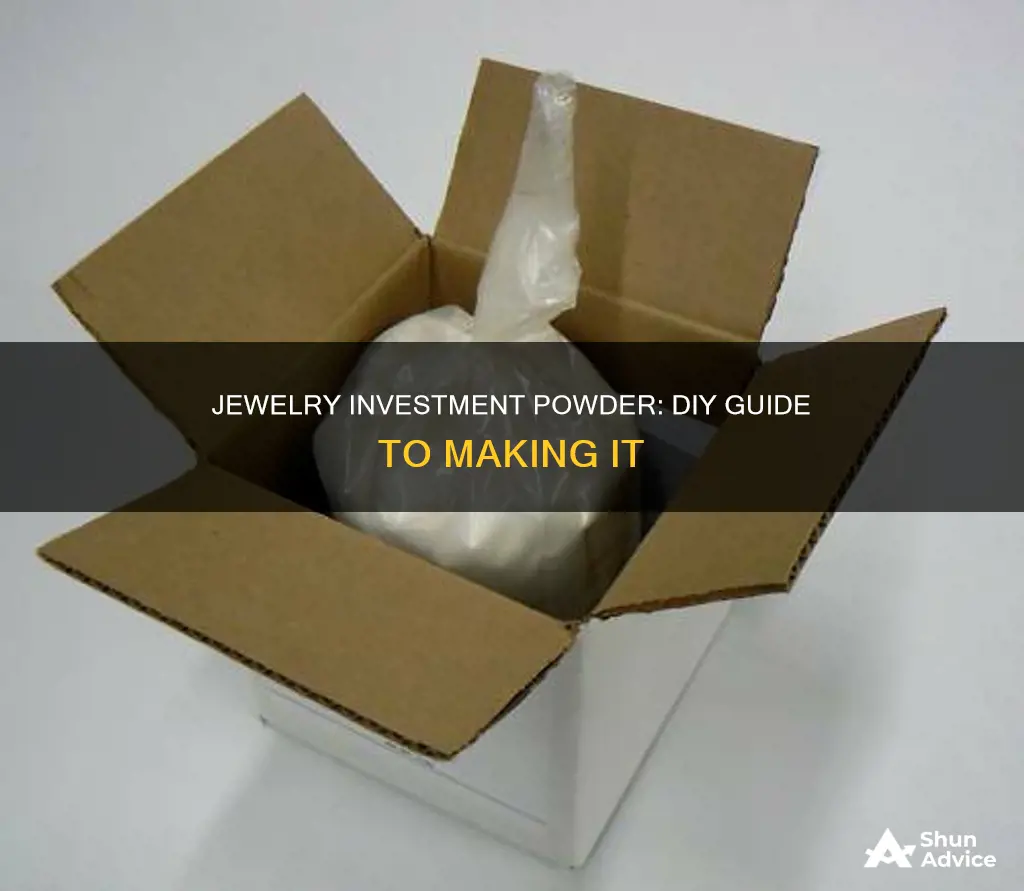
Investment powder is a key tool in the jewellery industry, used to create hollow moulds for casting. It usually contains gypsum and silica, with the former acting as a binder. The addition of water to the powder initiates a chemical reaction, causing the gypsum to transition from hemihydrate to dihydrate, which is essential to the casting process.
There are several factors to consider when making investment powder, such as water quality, temperature, and the water-to-powder ratio. Improper handling of the powder can lead to reduced casting quality and loss of production and money. It is important to follow the manufacturer's instructions and maintain process control to ensure the desired outcome.
There are also different types of investment powder available, such as the Yoshida Platinum Investment, specifically formulated for casting platinum, and SILK, which is suitable for all metals, particularly 18kt gold and fine filigree work.
| Characteristics | Values |
|---|---|
| Main ingredients | Gypsum, silica, crystalline quartz |
| Binder | Gypsum |
| Additional ingredients | Olivine sand, powdered fireclay, borax, wetting agents, defoaming agents, reducing agents, fibres |
| Water-to-powder ratio | 38-40% |
| Work time at 22°C | 8-9 minutes |
| Initial set time | 10-12 minutes |
| Thermal expansion at 750°C | 0.73% |
| Setting expansion after 2 hours | 0.65% |
| Cost | $3-7 per kilogram |
What You'll Learn

The importance of process control and handling
Process control and handling are critical when making jewelry investment powder. Improper handling can ruin the final product and cause a loss of production and money.
The first step in the process is to ensure you have the right ingredients. Investment powder usually contains gypsum and silica, with the former acting as a binder. Gypsum is the preferred material for jewelry-making due to its unique properties. The addition of water to the gypsum causes a chemical reaction, transitioning the gypsum from hemihydrate to dihydrate. This transition is followed by a volume expansion, which is essential to the casting process. The timing of this process is critical, and adding too much or too little water can impact the final product.
The next step is mixing. The investment powder must be thoroughly mixed with water to ensure a consistent product. Improper mixing methods or ratios can reduce casting quality. It is important to follow the manufacturer's instructions and mix the investment for the recommended amount of time.
Storage is another critical factor. Improper storage can lead to a loss of production and money. Investment powder should be stored in a closed container to prevent it from reacting with water in the air and deteriorating.
Temperature control is also vital. Uncontrolled temperatures can affect the setting time of the investment powder and impact the final product. It is important to maintain consistent temperatures during the process.
Finally, water quality is essential. Poor water quality can reduce casting quality. It is recommended to use de-ionized water when mixing investment powder to ensure consistent results.
By controlling the process and handling the investment powder properly, jewelry makers can create exquisite, complex items with high casting quality.
Capsim Process Management: Strategic Investment Initiatives for Success
You may want to see also

The role of water quality and temperature
Water quality and temperature play a significant role in the process of making jewellery investment powder.
Water quality is an important factor that can affect the investment properties. Using water of poor quality can lead to a reduction in casting quality and cause loss of production and money. Impurities in water, such as ions and other compounds, can interfere with the chemical reaction between the water and the investment powder, altering the rate of the reaction and leading to inconsistent results. Therefore, it is recommended to use de-ionized water, as it is free of ions that could impede the process and ensures consistency and trustworthy outcomes. De-ionized water removes ions, while distilled water removes minerals.
The temperature of both the water and the investment powder can also impact the investment properties. By controlling the temperature, variability in the process can be reduced. Increasing the temperature results in reduced pour time and set time, while fluidity remains relatively unaffected. Adjusting the temperature allows investors to slightly speed up or slow down the setting time, providing some flexibility in the investing process.
Overall, paying attention to water quality and temperature is crucial in maintaining the desired chemical reaction and achieving consistent and high-quality results in the production of jewellery investment powder.
India's Investment Landscape: Exploring 'What-If' Scenarios for Maximum Returns
You may want to see also

The impact of water-to-powder ratio
The water-to-powder ratio is a critical factor in the jewellery investment process. It is the ratio of water to investment powder, typically expressed as 40ml of water to 100g of investment powder. This ratio can be adjusted to change the properties of the investment, but it is important to stay within the recommended range to avoid casting defects.
The water-to-powder ratio affects the pour time, set time, fluidity, and strength of the investment. A higher water-to-powder ratio results in increased pour time, set time, and fluidity, while decreasing the strength of the investment. Within the recommended ratio range, the investor has some flexibility to change these properties to their liking. However, venturing outside this range can lead to problems such as cracking, rough surfaces, watermarks, non-fills, trapped air bubbles, and difficult mold breakaway.
The water quality used in the mixture is also important. Deionized water is recommended over distilled water as it removes ions that can interfere with the process, ensuring consistency and reliable outcomes. Accurate measurement of the water and powder is crucial, and a digital scale is recommended to ensure precise ratio measurements.
Additionally, the temperature of both the water and the investment powder can impact the investment properties. Higher temperatures result in reduced pour and set times, while fluidity remains relatively unchanged.
Overall, the water-to-powder ratio, water quality, temperature, and accurate measurement are critical factors that can affect the outcome of the jewellery investment process. By controlling these variables within the recommended ranges, investors can achieve consistent, high-quality castings.
European Equities: A Smart Investment Choice
You may want to see also

Choosing the right investment powder for your needs
When it comes to choosing the right investment powder for your jewellery-making needs, there are several factors to consider. Investment powder is a crucial component in the jewellery casting process, and selecting the right one can make a significant difference in the final product's quality and precision. Here are some guidelines to help you make an informed decision:
Understand the Basics of Investment Powder
Investment powder is a mixture of gypsum and silica. Gypsum acts as a binder, holding the various components together. Silica contains crystalline quartz, which is essential in the jewellery casting process. When water is added to the investment powder, a chemical reaction occurs, converting gypsum from its hemihydrate state to dihydrate. This transition is accompanied by a volume expansion, which is crucial for the casting process and impacts the investment's strength at different stages.
Consider the Type of Jewellery You Want to Create
Different types of jewellery require specific investment powders to achieve optimal results. For instance, if you are casting platinum jewellery, you should consider using a specialised investment powder like Yoshida's line of investments, which is formulated specifically for platinum casting. On the other hand, if you are working with high-karat gold or fine filigree items, you may opt for investment powders such as SILK, which is designed for high-quality casting and offers increased refractoriness, resulting in better thermal shock resistance during burnout and casting.
Evaluate the Cost and Scalability
The cost of investment powder can vary, and it's important to consider your budget, especially if you plan to scale up your production. Commercial investment powders can range from $3 to $7 per kilogram, and making your own investment powder might be a more cost-effective option for large-scale casting. However, it's essential to carefully research the ingredients and their ratios to ensure a successful outcome.
Assess the Technical Support and User-Friendliness
When choosing an investment powder, consider the level of technical support and user-friendliness it offers. Some investment powder manufacturers provide comprehensive user instructions and technical support to help you control process variables and ensure consistent results. Additionally, look for investment powders that are easy to work with and offer a smooth, creamy consistency during mixing and pouring, such as SILK, which is known for its user-friendly characteristics.
Pay Attention to the Stages of Investment Strength
Understanding the stages of investment strength is vital for jewellery casting. Green strength refers to the strength of the investment before it enters the furnace, while burned strength refers to the strength attained after the furnace process. Choosing an investment powder that provides adequate strength at each stage will ensure the integrity of your jewellery pieces during the casting process.
In conclusion, selecting the right investment powder for your jewellery-making endeavours requires careful consideration of various factors. By taking into account the type of jewellery you want to create, cost implications, technical support, user-friendliness, and the stages of investment strength, you can make an informed decision that aligns with your specific needs and helps you achieve the desired results in your jewellery casting process.
Investing vs. Saving: What's the Real Difference?
You may want to see also

Mixing and pouring techniques
Mixing Techniques:
- Always use de-ionized water to mix with the investment powder. This will help remove any impurities that may affect the setting time and fluidity of the mixture.
- Measure the water-to-powder ratio accurately. A common ratio is 40ml of water for every 100g of investment powder. However, you can adjust this ratio slightly to change the properties of the mixture, such as pour time, set time, and fluidity.
- Mix the water and powder thoroughly. Insufficient mixing can negatively affect the casting quality. Follow the user instructions provided by the manufacturer for the specific product you are using.
- Control the temperature of the water and powder. The setting rate can be altered by changing the temperature, which will impact the pour time and set time.
- Be mindful of the working time. This is the time from when you start mixing until the mixture becomes too viscous to work with.
- Add any necessary modifying agents, wetting agents, defoaming agents, and reducing agents as recommended by the manufacturer.
Pouring Techniques:
- Ensure the investment mixture is smooth and creamy during pouring.
- Pour the investment into a mould in a slow and controlled manner to avoid air bubbles and uneven filling.
- Fill the mould in multiple stages, vacuuming between each stage to remove any air bubbles.
- After filling, set the mould aside to harden.
- Follow the manufacturer's instructions for the burnout schedule.
- Cast your desired metal into the hollow chamber created by the investment mould.
Remember that improper handling of investment powder can lead to reduced casting quality. Always follow the specific instructions provided by the manufacturer and take your time to ensure a precise and controlled process.
Crafting a Board Game: Investing and Winning
You may want to see also
Frequently asked questions
The basic recipe for jewellery investment powder typically includes gypsum and silica. Some recipes also suggest adding refractory materials such as olivine sand or powdered fireclay to increase the melting point.
The two main stages of investment strength are green strength and burned strength. Green strength refers to the strength of the investment before it enters the furnace, while burned strength is the strength attained after the furnace process.
The ideal water-to-powder ratio can vary depending on the specific product and application. A common range is between 38-40% powder to water by volume. However, it is important to carefully measure and follow the manufacturer's instructions to ensure optimal results.
Adding water to the jewellery investment powder initiates a chemical reaction that transforms the gypsum from hemihydrate to dihydrate, causing a volume expansion. This chemical process is time-sensitive and can impact the final product if not executed correctly.







